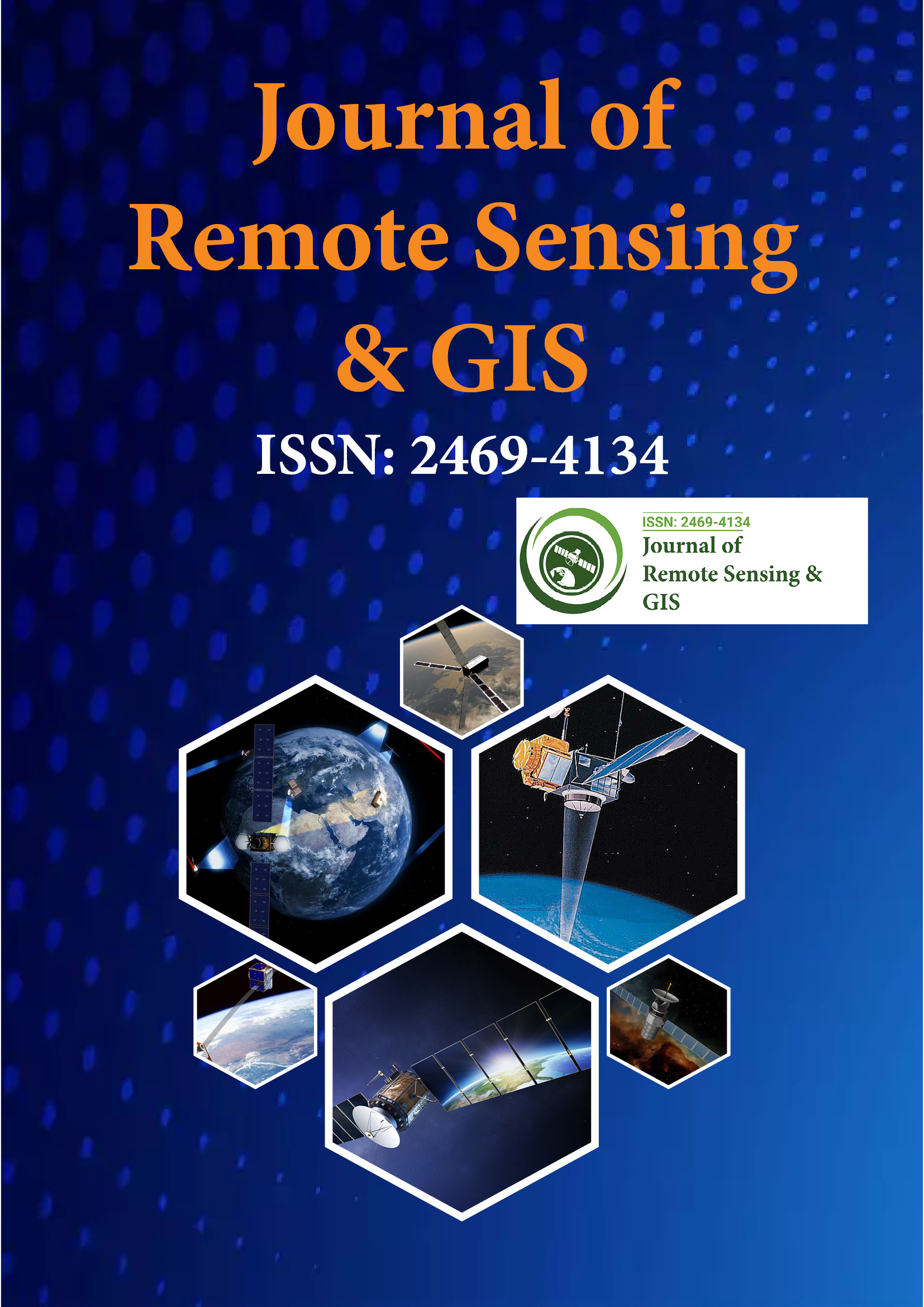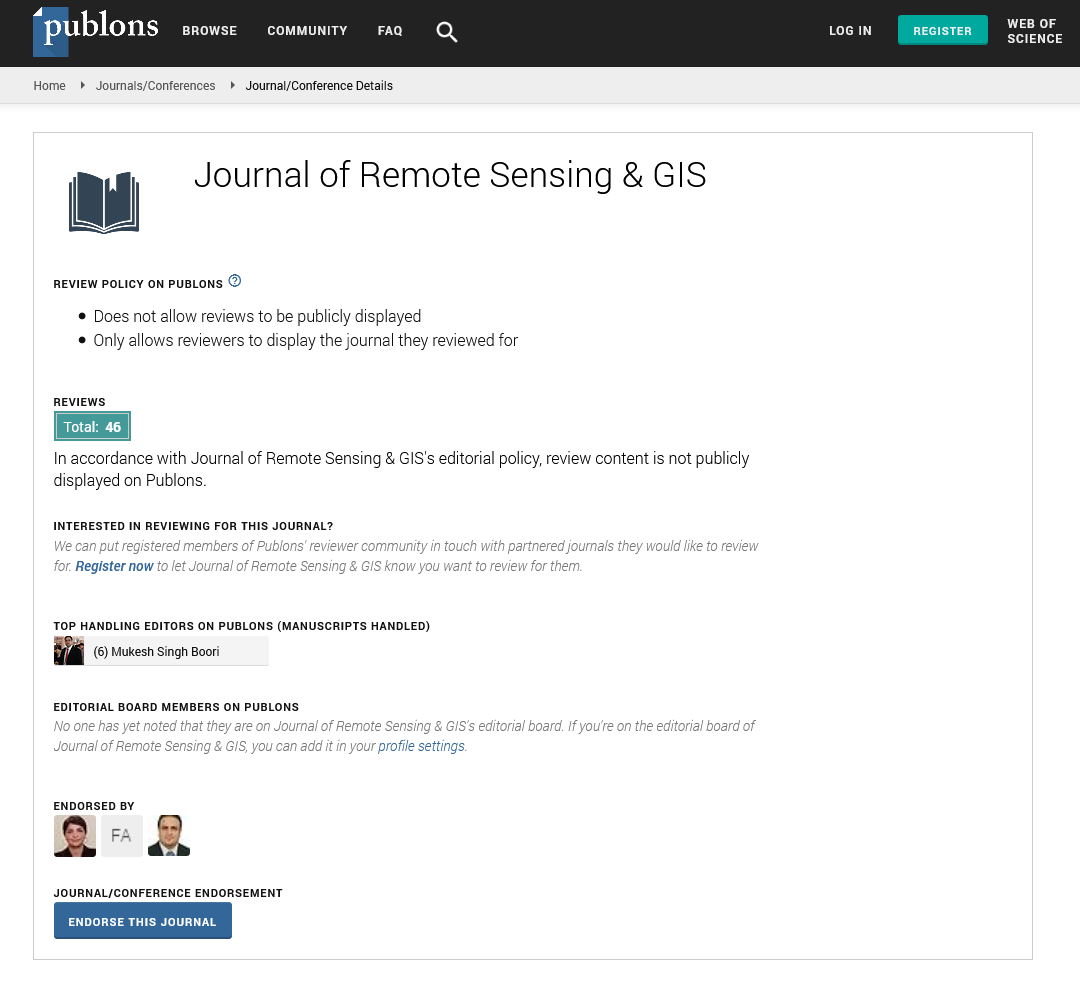Indexed In
- Open J Gate
- RefSeek
- Hamdard University
- EBSCO A-Z
- OCLC- WorldCat
- Publons
- International Scientific Indexing
- Euro Pub
- Google Scholar
Useful Links
Share This Page
Journal Flyer

Open Access Journals
- Agri and Aquaculture
- Biochemistry
- Bioinformatics & Systems Biology
- Business & Management
- Chemistry
- Clinical Sciences
- Engineering
- Food & Nutrition
- General Science
- Genetics & Molecular Biology
- Immunology & Microbiology
- Medical Sciences
- Neuroscience & Psychology
- Nursing & Health Care
- Pharmaceutical Sciences
Opinion Article - (2025) Volume 14, Issue 1
Advances in Geoinformatics: Spatial Analysis and Visualization Techniques for Sustainable Development
Jameson Knorr*Received: 25-Feb-2025, Manuscript No. JGRS-25-28691; Editor assigned: 27-Feb-2025, Pre QC No. JGRS-25-28691 (PQ); Reviewed: 14-Mar-2025, QC No. JGRS-25-28691; Revised: 21-Mar-2025, Manuscript No. JGRS-25-28691 (R); Published: 28-Mar-2025, DOI: 10.35248/2469-4134.25.14.377
Description
Geoinformatics is an interdisciplinary field that focuses on the acquisition, analysis, storage and visualization of spatial and geographic data. It combines elements of geography, computer science, environmental science and remote sensing to support decision-making in a variety of sectors. From urban development to disaster response and from agriculture to climate monitoring, geoinformatics plays an increasingly central role in addressing spatially-referenced questions.
With the advancement of satellite imaging, Geographic Information Systems (GIS), Global Positioning Systems (GPS) and data analytics, geoinformatics offers tools for understanding and managing both natural and human-made environments. Its integration with modern technologies has allowed researchers and policymakers to examine complex spatial patterns and develop informed strategies for planning and resource management.
Core components of geoinformatics
The foundation of geoinformatics rests on several key technologies and methodologies:
Remote sensing: Remote sensing refers to the process of collecting information about the Earth's surface without direct contact, typically using satellite or airborne sensors. These sensors capture data across multiple spectral bands, enabling the observation of land cover, vegetation, water bodies and urban areas.
Geographic Information Systems (GIS): GIS provides a framework for storing, analyzing and visualizing spatial data. It allows for the layering of various datasets, such as topography, population density, infrastructure and climate, to explore relationships and trends. GIS supports spatial modeling, thematic mapping and location-based analysis.
Global Navigation Satellite Systems (GNSS): Including GPS and other regional systems like GLONASS and Galileo, GNSS enables precise positioning and navigation. This is essential for applications such as surveying, mapping, transportation logistics and field data collection.
Cartography and visualization: Effective communication of spatial information relies on accurate and visually accessible maps. Cartographic techniques in geoinformatics enhance the presentation of data, aiding interpretation by technical experts and non-specialists alike.
Spatial Data Infrastructure (SDI): SDI refers to the frameworks and standards that enable the sharing, integration and accessibility of spatial data among organizations and users. It includes policies, metadata standards and platforms for data dissemination.
Applications of geoinformatics
The flexibility of geoinformatics makes it applicable to a broad range of disciplines. Some of the most prominent areas include:
Environmental monitoring and management: Geoinformatics tools are widely used to monitor natural resources, detect land use changes and assess environmental degradation. Remote sensing enables continuous observation of ecosystems, while GIS supports the spatial analysis of trends such as deforestation, wetland loss and soil erosion.
Urban planning and infrastructure development: Urban planners use geoinformatics to analyze population growth, traffic patterns and land suitability for development. GIS helps in zoning, infrastructure mapping and utility management. Remote sensing data provide timely updates on urban expansion and environmental impacts.
Disaster risk reduction and emergency response: During natural disasters, such as floods, earthquakes and wildfires, geoinformatics tools assist in real-time assessment and response. Satellite images help identify affected areas, while GIS models can predict hazard-prone zones and guide evacuation planning. GNSS supports coordination of relief efforts and field operations.
Agriculture and food security: In agriculture, geoinformatics aids in crop monitoring, soil analysis and irrigation management. Multispectral imagery can detect plant stress, disease, or nutrient deficiencies. GIS-based models assist in yield estimation and identifying suitable areas for cultivation based on climatic and soil data.
Climate and weather studies: Geoinformatics contributes to the monitoring of climate variables, including temperature, precipitation and sea-level rise. Long-term satellite data allow researchers to assess changes in ice cover, desertification and vegetation dynamics. This information is essential for understanding climate change and supporting adaptation strategies.
Public health and disease mapping: In the health sector, geoinformatics supports epidemiological studies by mapping disease outbreaks and identifying spatial correlations with environmental or socio-economic factors. This spatial perspective improves surveillance and resource allocation during public health interventions.
Technological advancements and integration
The field of geoinformatics continues to evolve with the integration of emerging technologies. Artificial Intelligence (AI) and machine learning are now used to analyze large volumes of spatial data for pattern detection and predictive modeling. Unmanned Aerial Vehicles (UAVs), or drones, provides highresolution and near real-time imagery, making them valuable for localized monitoring.
Cloud-based platforms have made spatial data processing and sharing more accessible, allowing researchers to collaborate across regions and disciplines. Open-source GIS software and public data repositories have further democratized access to spatial information, encouraging broader participation in spatial analysis.
Challenges and future directions
Despite its growth, geoinformatics faces several challenges. Data standardization remains a concern, especially when integrating datasets from multiple sources. Ensuring data quality and accuracy is essential, particularly for decision-making applications. Privacy issues also arise in applications involving human mobility or sensitive infrastructure.
Moving forward, there is a growing need for capacity building in geoinformatics, especially in regions where technical expertise and infrastructure are limited. Education and training programs can help expand the use of spatial tools in both research and policy contexts.
As spatial data becomes increasingly central to understanding global challenges, geoinformatics is poised to support informed action across sectors. Its ability to connect data with location offers a unique lens through which to interpret the complexities of the modern world.
Conclusion
Geoinformatics provides a powerful framework for analyzing spatial phenomena across environmental, social and economic domains. Through its integration of remote sensing, GIS, GNSS and data science, it enables users to interpret patterns, assess changes and support planning efforts. As technology advances and spatial data become more available, geoinformatics will continue to contribute to sustainable development and scientific exploration.
Citation: Knorr J (2025) Advances in Geoinformatics: Spatial Analysis and Visualization Techniques for Sustainable Development. J Remote Sens GIS.14:377.
Copyright: © 2025 Knorr J. This is an open-access article distributed under the terms of the Creative Commons Attribution License, which permits unrestricted use, distribution and reproduction in any medium, provided the original author and source are credited.

